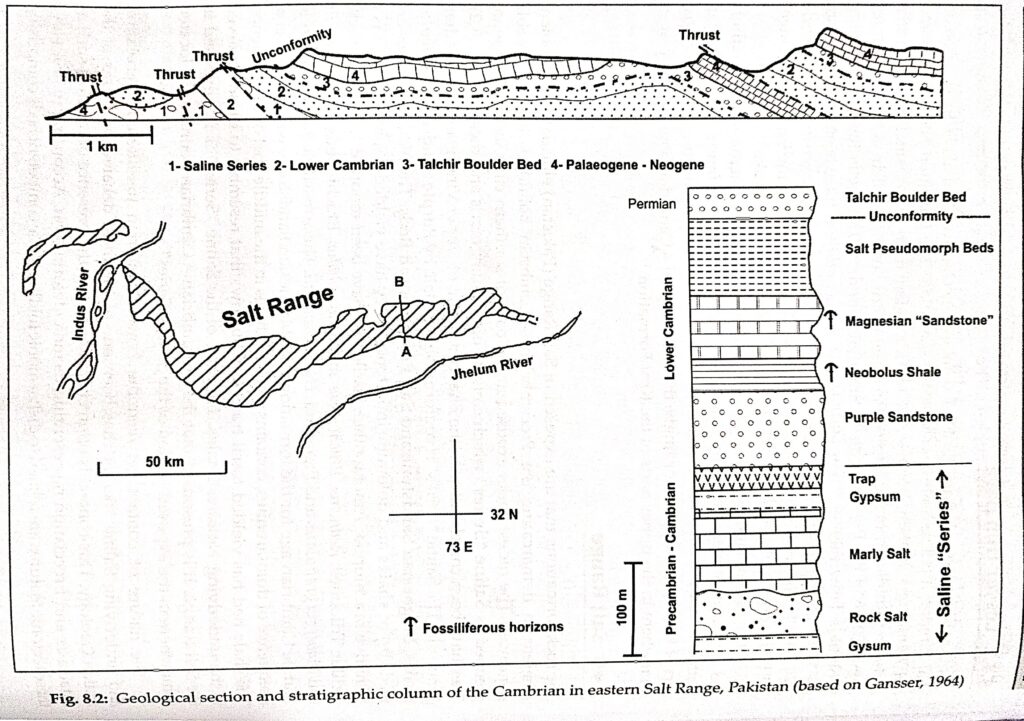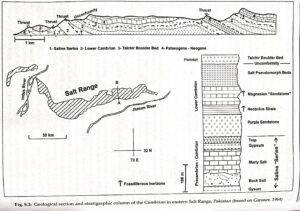Contrasts in Palaeozoic and Precambrian Rock Records
The Palaeozoic rock formations are renowned for their rich fossil records, starkly contrasting the largely unfossiliferous nature of Precambrian rocks. This distinction raises intriguing questions about the sudden appearance of abundant and complex life forms at the beginning of the Palaeozoic Era. Several theories have been proposed to explain the scarcity and primitive nature of fossil records in Precambrian rocks:
- Sudden Evolutionary Acceleration: One possibility is a rapid increase in the rate of evolution from primitive organisms in the Late Precambrian to more complex forms found in the Cambrian. This theory suggests that a significant evolutionary event might have triggered the diversification and complexity seen at the start of the Cambrian.
- Lack of Hard Parts in Precambrian Organisms: Another explanation is that Precambrian life forms lacked hard parts, such as shells or bones, which are necessary for fossilization. As a result, these soft-bodied organisms were not preserved as body fossils, leaving little to no fossil evidence in Precambrian strata.
- Deep Water Habitats: It is also hypothesized that many Precambrian organisms lived in deep marine environments where conditions were not conducive to sedimentation and fossil preservation. This would mean that these organisms left behind minimal fossil evidence.
Despite these theories, the lack of requisite fossils in rocks older than the Cambrian remains a significant puzzle for geologists and paleontologists.
Defining the Base of the Cambrian Period
The base of the Cambrian Period is traditionally marked by the first appearance of skeletal fossils, predominantly trilobites. This discovery led to the hypothesis of an “explosive” event in organic evolution at the Precambrian-Cambrian boundary, suggesting a sudden emergence of complex life forms. Subsequent discoveries expanded the fossil record to include other groups such as brachiopods, archaeocyathids, mollusc-like univalves, non-trilobite arthropods, and various trilobites including Olenellina and Redlichina. These findings indicate a more gradual transition rather than an abrupt explosion of life forms.
Cambrian System in North Wales and Other Global Regions
North Wales, Britain:
- The Cambrian System in North Wales is characterized by a sequence of sandstones and shales, which are rich in fossils such as trilobites, brachiopods, and graptolites. The fossil assemblages differ from bed to bed, displaying a distinctive order of succession.
- Notably, the trilobite genera Paradoxides, Olenus, Orusia, Peltura, and Niobe are found in a specific stratigraphic order from older to younger beds. Paradoxides, for instance, appear in the type section at approximately 1400 meters above the base of the exposed Cambrian sequence.
Sweden:
- Similar fossil successions are found in Cambrian sequences in parts of Sweden. The oldest Cambrian beds here have yielded the trilobite genus Holmia, which rests unconformably over Precambrian gneisses and schists, further illustrating the global nature of this boundary.
Siberian Platform, Russia:
- In Russia, excellent sections of Lower Cambrian rocks are exposed on the Siberian Platform. These rocks, lying unconformably over Precambrian rocks, have yielded a diverse array of fossils including archaeocyathids, gastropods, hyolithids, hyolithelminthids, poryferids, and tommodtiids.
- The Lower Cambrian succession on the Siberian Platform has been divided into three stages based on distinct faunal assemblages: the Tommotian Stage (pre-trilobite), the Atdabanian Stage (trilobitic), and the Lenian Stage.
Terminology for Precambrian-Cambrian Transition
Various terms have been used to describe the time of deposition of sediments around the Precambrian-Cambrian boundary:
- Eocambrian: This term, used in Scandinavia, signifies the dawn of the Cambrian and denotes the strata just before the Cambrian explosion of life.
- Vendian System: This term is used for the youngest sequence of Precambrian rocks on the Russian Platform, dating from approximately 670 to 540 million years ago. These rocks primarily contain stromatolites and some acritarch forms.
- Ediacaran Period: Introduced to describe the time interval of strata yielding the Ediacaran Fossil Assemblage, this period represents a crucial transitional phase at the end of the Precambrian Eon. The Ediacaran assemblage is characterized by a range of soft-bodied organisms and has been found in various locations worldwide, including northeastern Russia, Siberia, Norway, Central England, South Wales, North America, South America, and southwest Africa.
Ediacaran Fauna Characteristics
The Ediacaran fauna predominantly consists of organisms from the phylum Cnidaria (Coelenterata), including:
- Cnidarians: The Australian sequence alone has yielded 19 species of cnidarians.
- Annelid Worms: Five species have been identified.
- Primitive Arthropods: These early arthropods are part of the Ediacaran assemblage.
- Tribrachidium: An echinoderm with a unique three-fold symmetry, distinct from the typical five-fold symmetry seen in later echinoderms.
- Metazoans: These more complex organisms consist of differentiated cells forming tissues and organs, distinguishing them from colonial single-celled organisms.
In addition to body fossils, the Ediacaran assemblage includes trace fossils, such as burrows left by worm-like organisms, offering valuable insights into the behavior and diversity of Precambrian life.
Ediacaran / Cambrian Chronological Events
| Time | Event |
|---|---|
| ~550 Ma | Appearance of the earliest trilobites |
| 541 Ma | Beginning of Paleozoic Era was marked by Cambrian explosion of life forms, extraordinary diversification of marine animals, widespread growth of plants, and colonization of first vertebrates on land |
| 600 – 570 Ma | Base of the Tommotian Stage |
| 650 – 600 Ma | Appearance of soft-bodied fauna (Ediacaran) |
| ~1000 – 650 Ma | Global glacial event |
Global Sections for Precambrian-Cambrian Demarcation
Three significant global sections have been identified for the correlation of the Precambrian-Cambrian boundary:
- Burin Peninsula, Newfoundland (Canada)
- Meishucun, Yunnan Province (China)
- Ulakhan, Aldan River (Siberia, Russia)
The Global Stratotype Section and Point (GSSP) for this boundary has been established at the Kunyang Quarry Section in Yunnan Province, China. Here, the boundary is marked by a distinct bed sequence: the bed above the boundary consists of quartzose, phosphatic, and manganiferous dolomite intercalated with striped cherts, while the bed below contains siliceous phosphorite and phosphatic shales.
Indian Subcontinent: Key Locations and Fossil Discoveries
Tethyan Himalaya:
- The Tethyan Himalaya exposes continuous sedimentary successions from Precambrian to Cambrian. Notable sections include those in Kashmir, Spiti, and Kumaon. These sequences often show a transition from unfossiliferous Precambrian rocks to fossiliferous Cambrian strata. For example, the fossiliferous Lower Palaeozoic rocks in Kashmir rest conformably over the unfossiliferous Dogra Slate. Similarly, the Kunzamla Formation in Spiti shows a transition from acritarchs of Vendian affinity in its lower parts to trilobites and trace fossils of upper Lower Cambrian affinity in its upper parts.
Lesser Himalaya:
- In the Garhwal region, the Krol-Tal sequence marks the Precambrian-Cambrian transition. This sequence contains a variety of fossils, including algae, small shelly fauna, archaeocyathids, trilobite impressions, and trace fossils, which are critical for demarcating the boundary. The Tommotian fossil assemblage, similar to that of the Siberian Platform, has been reported from the base of the Lower Tal formation in the Mussorie area.
Salt Range, Pakistan:
- The Salt Range offers an intriguing view of the Precambrian-Cambrian transition, with a sequence of formations including the Saline “Series,” Purple Sandstone, Neobolus Shales, and Magnesian Sandstone. The Saline “Series” consists of gypsum, marl, and rock salt, and is conformably overlain by the other formations, which contain a range of fossils, including the primitive brachiopod Neobolus and various trilobites. The nature of the contact between the Saline “Series” and the overlying Cambrian sequence has been a subject of debate, with discussions on whether it represents a normal stratigraphic contact or a thrust contact influenced by tectonic activity.
Geological Insights and Stratigraphic Studies
The boundary between the Lower Cambrian fossiliferous succession and the underlying Saline “Series” in the Salt Range, Pakistan, has been a focus of intense study. The debate includes whether the contact is conformable or represents a tectonic thrust. Features such as cataclasis and brecciation suggest significant geological processes. Further investigations into the sedimentary cycles and fossil assemblages from this region continue to provide valuable insights into the Precambrian-Cambrian transition, offering a window into a critical period in Earth’s biological and geological history.


